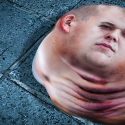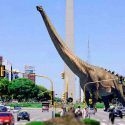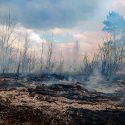Body-crushing pressure. Toxic atmospheres. Unbearable temperatures. That’s what would be in store if you visited other planets in our Solar System. But what other environmental hazards would you encounter? Which planets would be the safest and which would be the most dangerous? And how long could you survive on any of them?
Before you get started on your journey through the Solar System, you should pack a bottle of water. Earth is the only planet known to have consistent bodies of liquid water on its surface. So if you pack enough, you could probably survive a few days just about anywhere, right? Well, sorry to say, I’ve got some bad news for you.
MERCURY
Let’s start with a visit to Mercury, the smallest planet in the Solar System. This rocky, crater-filled planet is only slightly larger than our Moon. And it’s located extremely close to the Sun at a distance of 58 million km (36 million mi). Even though a day on Mercury equals about 59 days on Earth, your trip wouldn’t last anywhere near that long.
Due to this slow rotation, you could land on the sunny half, where temperatures reach 430 °C (800 °F). Or maybe you’d aim for the dark side, where temperatures drop to -180 °C (-290 °F). Your best bet would be to find a cozy spot somewhere in between. But with an atmosphere mainly composed of oxygen, sodium, hydrogen, helium and potassium, good luck breathing for very long. Even in this middle ground, you wouldn’t likely survive more than two minutes.
VENUS
Let’s check out what a day would be like on the second planet from the Sun, Venus. You should expect a very warm welcome because surface temperatures are a piping hot 475 °C (900 °F). And one day on Venus lasts 243 Earth days. Unless you’ve got an impossibly robust spacecraft, you couldn’t get very close to the surface. And even if you did, you wouldn’t last very long.
Venus has a thick and toxic atmosphere with154,000 times more carbon than the atmosphere of Earth. And it’s shrouded in yellowish clouds of sulfuric acid. You could say the Venusian atmosphere is a runaway greenhouse effect. Between the toxicity and the heat burning you to a crisp, you wouldn’t survive one second on Venus.
MARS
Now, let’s skip on over to Mars. Unless you wanted to stop back on Earth for a couple of breaths of fresh air. On Mars, you’d find comfort in a day that is a little over 24 hours. What you wouldn’t find comfortable is an atmosphere of carbon dioxide, argon, nitrogen and a little bit of oxygen and water vapor.
The surface of Mars is cold, with an average temperature of -62 °C (-80 °F). Combine surface temperatures too low to conform and unbreathable air, and you wouldn’t survive much more than a few minutes here either.
JUPITER
On the next planet, you wouldn’t be able to reach the surface. That’s because there isn’t one on the gas giant, Jupiter. This planet is more than twice as massive as all the other planets in our Solar System combined. And its atmosphere is primarily hydrogen, helium and cold, windy clouds of ammonia and water.
Jupiter might be bulky, but it rotates fast. One day lasts a mere 10 Earth hours. And because it’s so fast, Jupiter’s atmosphere has strong jet streams. Plus, the Great Red Spot that is a storm bigger than Earth.
If you fell into the planet, you would enter the atmosphere at a whopping 49 km/s (30 mi/s). And as you kept falling, the atmosphere would become denser and more turbulent. You might feel like you were slamming into a wall again and again.
If you made it 692 km (430 mi) down, you would find pressure levels higher than at the bottom of the Mariana Trench, the deepest place on Earth. If the pressure didn’t kill you, the temperature, which averages -145 °C (-229 °F), certainly would. You wouldn’t survive on Jupiter for one second.
SATURN
Now, if you continued on to Saturn, you’d find another gaseous giant without a surface. And, like Jupiter, a day that lasts about 10.7 hours. Here you would experience deadly strong winds reaching up to 1,800 km/h (1,118 mph).
With an unbreathable atmosphere made of hydrogen and helium, Saturn is incapable of supporting life. But maybe you would have more luck on one of its moons. Take Titan and Enceladus. These two moons have internal oceans, which could theoretically support life.
URANUS
Moving onto the first of the ice giants in our Solar System. Uranus. Uranus has a day that lasts about 17 hours. But you would want to reorient yourself considerably. Uranus rotates east to west and on its side.
No surprise here that it also has an unbreathable atmosphere of hydrogen, helium and methane, which gives the planet its signature blue-green color and the stink of rotten eggs. There are some other unusual hazards on Uranus you’d need to be prepared for, such as mysterious flares of X-rays and lethal diamond rain.
You heard that right. Highly compressed diamonds of carbon atoms raining down from the atmosphere. But don’t worry. The immense pressure would kill you in less than a second.
NEPTUNE
Last but not least, Neptune. A dark, cold planet with supersonic winds as strong as 2,000 km/h (1,200 mph). That’s faster than the top speed of a fighter jet. So if the pressure didn’t kill you, those supersonic winds would probably do the trick. A day on Neptune would last for 16 Earth hours. But your life there wouldn’t last a second.
OK, there it is. So in case it isn’t clear, Earth would be the only planet you want to visit anytime soon. Just about anywhere else, you could look forward to a deadly cocktail of high pressure and toxic gas. That’s unless we terraformed Mars, creating a second home for humanity within the Solar System.
Sources
- “The Solar System And Beyond Is Awash In Water”. 2015. nasa.gov.
- “Water On Mercury – Universe Today”. Fraser Cain. 2009. universetoday.com.
- “Are There Oceans On Other Planets?”. 2021. oceanservice.noaa.gov.
- “How Long Can You Live Without Water? Effects Of Dehydration”. Natalie Silver. 2021. healthline.com.
- “Mercury”. 2021. solarsystem.nasa.gov.



























